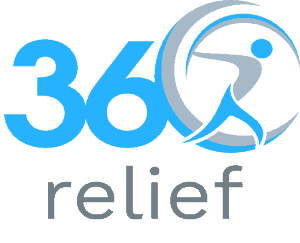
Make This Christmas Pain-Free: 10% Off on Supportive Wear!
Holidays are coming, which means that let’s welcome them with joy, laughter, and, of course, some comfort! At 360 Relief,

As the weather turns decidedly colder and frost starts appearing on the ground, the risks associated with winter injuries rise. Whether it is avoiding slipping on ice or protecting ourselves from winter sports injuries, it’s time to start working out how to prevent winter injuries .
Table of Contents
ToggleFrom taking a few sensible precautions to choosing the right injury support wrap or brace, there is plenty that can be done to lessen both the risk of injury and the impact of winter injuries. There are all kinds of winter injury risks to watch out for. Here are some of the more common ones.
Everyone either knows someone who has fallen while walking on slippery ice or snow, or has done it themselves. Consequences can be serious injuries including broken bones, dislocated joints, head injuries and bruising. Not to mention loss of confidence and subsequent feelings around trauma. Wet, slushy pavements are bad news for pedestrians who slip and fall with wrist and shoulder injuries a common occurrence.
Other complications can include head injuries and concussion, broken hips and ankle sprains. In the case of sprains and strains, choosing a good joint support wrap or brace can make a huge difference in easing pain and speeding up recovery.

Wear proper footwear when going outside.Watch the weather forecast to be pre-warned about any problematic conditions and plan your errands and schedule as much as possible around when it is safer to go outside.
Driving on slippery roads and driveways can also be extremely dangerous in the winter season and it is worth taking extra time for journeys during lower temperatures. Even before you drive away, winter injuries can occur from shovelling snow from the driveway. All that bending over and repetitive use of the muscles needed to clear the snow can lead to muscle strains and soft tissue damage to the lower back. The same goes for scraping ice from the car windscreen. Overstretching or vigorous scraping can both lead to pulled muscles and rotator cuff injuries.
Once you have set off, the roads themselves can be treacherous. Collisions and other vehicle accidents become more common. Drive more slowly than usual and be careful when it comes to manoeuvres such as changing lanes or pulling on and off main roads. Again, using the right supportive brace, strap or wrap can really help pull muscles in the back and joints to heal faster.

Winter brings with it several religious and cultural celebrations, including Christmas. While these are wonderful times to enjoy time with family, fine food etc., they also bring their own winter injuries. Be careful when standing on ladders, chairs or rooftops to fix festive lights. Avoid heavy lifting as much as possible, e.g. lugging large presents or Christmas trees around. Always use your knees if you do have to carry heavy objects.
Watch out for burns from hot ovens, lit fires etc, and watch those scissors and blades used to open presents. It is all too easy to miss the sticky tape or twine and catch your fingers or hand instead in all the excitement. If you do suffer a serious burn or cut, seek emergency medical help immediately. Additionally, do not ignore any pulled muscles or strains gained over the festive period as these can become exacerbated if not treated quickly and correctly.
Participating in winter sports is well-known for their winter injuries risk as it is a fun factor. Some common winter or cold weather sports that carry enhanced injury risks include rugby, ice hockey, skiing, snowboarding, sledging and ice skating. Common winter injuries in sports often include pulled muscles, strains and sprains in knees, elbows and wrists due to hard landings or slipping on frosty ground and seeking a lot of medical attention. Doctors also see a lot of broken bones and torn ligaments, particularly the anterior cruciate ligament.

Cut down the risks of this type of winter injuries in sports happening by noting the following safety tips. Warm up and cool down properly at the start and end of training sessions or matches. Wear protective goggles when skiing, skating or sledging. for injury prevention Always hydrate yourself with water or suitable sports drinks. Never go out to train, run etc. alone and carry a mobile phone to seek help if required. Get your strain or sprain support wrap or brace properly fitted if you do experience a winter sports injury to aid healing and ease discomfort.

Holidays are coming, which means that let’s welcome them with joy, laughter, and, of course, some comfort! At 360 Relief,

Happy Cyber Monday to everyone; it is a perfect occasion for 360 Relief to offer a special discount of 10%

This Black Friday, take advantage of exclusive 10% savings on some of 360 Relief’s best-selling compression socks and support braces!

Everyday life includes walking up stairs, but knee discomfort can make this basic activity difficult. Walking up or down stairs

Cooking is a beloved activity for many, but for those struggling with knee pain, standing in the kitchen can quickly

We’ve all been there. On a ride in a car, for instance, to the country home for a weekend break

Gardening is enjoyable for many people and those who like tending to their lawns and plants usually find it therapeutic

Do you have a painful knee problem that takes you to physiotherapy…for an injury that hampers your daily living…your workout

Training can be very much associated with some pains and injuries that may be experienced by the trainers. As there

Office workers often spend hours seated at their desks, focusing on tasks while unknowingly putting their health at risk. The

Winter often brings more than just a change in weather; for many, it also means dealing with unexpected swelling in

Compression socks have become a critical tool for athletes across all sports. Whether you’re a marathon runner, cyclist, or weightlifter,

October marks the beginning of National Cholesterol Month in the UK, a time dedicated to raising awareness about cholesterol and

Overall, there is nothing to match the experience of watching musicians perform live in an outdoor concert in Glastonbury. However,

Today charity runs have gained popularity as a way of raising cash for a cause in the United Kingdom. From
Please enter your email to subscribe to our newsletter for exclusive offers and updates
Copyright © 2025 | 360 Relief Ltd | Sitemap

